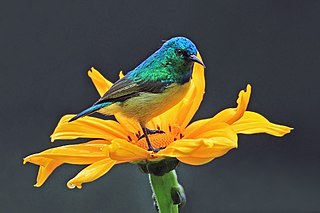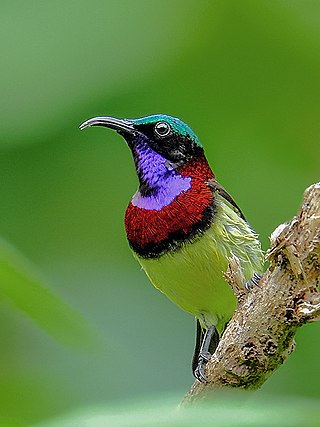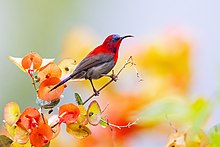
The splendid sunbird is a sunbird. The sunbirds are a group of very small Old World passerine birds which feed largely on nectar, although they will also take insects, especially when feeding young.

The beautiful sunbird, formerly placed in the genus Nectarinia, is a sunbird. It is native to tropical Africa, its range extending from Senegal and Guinea in the west to Sudan, South Sudan, Ethiopia, Tanzania and Kenya in the east.

The collared sunbird is a bird species of the family Nectariniidae. The sunbirds are a group of very small Old World passerine birds which feed largely on nectar, although they will also take insects, especially when feeding young. The collared sunbird is in fact mainly insectivorous.

The garden sunbird, previously known as the olive-backed sunbird, is a species of passerine bird in the family Nectariniidae that is found in the Philippines except on the Palawan island group. It was formerly considered to be conspecific with seven other species: the ornate sunbird, Palawan sunbird, Sahul sunbird, Tukangbesi sunbird, Flores Sea sunbird, South Moluccan sunbird and the Mamberamo sunbird. It is a small, brightly coloured bird with olive-green plumage on the wings and back with a bright yellow chest. It has a long downward-curved bill it uses for taking nectar and capturing insects. It is primarily nectarivorous, but will take insects and spiders, particularly when feeding chicks.

The purple sunbird is a small bird in the sunbird family found mainly in South and Southeast Asia but extending west into parts of the Arabian peninsula. Like other sunbirds they feed mainly on nectar, although they will also take insects, especially when feeding young. They have a fast and direct flight and can take nectar by hovering like a hummingbird but often perch at the base of flowers. The males can appear all black in harsh sunlight but the purple iridescence is visible on closer observation or under good light conditions. Females are olive above and yellowish below.

The purple-rumped sunbird is a sunbird endemic to the Indian Subcontinent. Like other sunbirds, they are small in size, feeding mainly on nectar but sometimes take insects, particularly when feeding young. They can hover for short durations but usually perch to lap nectar from flowers. They build a hanging pouch nest made up of cobwebs, lichens and plant material. Males are contrastingly coloured but females are olive above and yellow to buff below. Males are easily distinguished from the purple sunbird by the light coloured underside while females can be told apart from males by their whitish throats.

The crimson-backed sunbird or small sunbird is a sunbird endemic to the Western Ghats of India. Like other sunbirds, they feed mainly on nectar although they take insects, especially to feed their young. They are tiny birds that are resident and are found in forests but are particularly attracted to gardens at the edge of the forest where people grow suitable flower-bearing plants. They usually perch while taking nectar.

The orange-breasted sunbird is a species of small, predominantly nectar-feeding bird that is endemic to the fynbos shrubland biome of southwestern South Africa. It is the only member of the genus Anthobaphes, in the family Nectariniidae, though it is sometimes placed in the genus Nectarinia. The birds are sexually dimorphic, with females being olive green while the males are orange to yellow on the underside with bright green, blue and purple on the head and neck.

The malachite sunbird is a small nectarivorous bird found from the highlands of Ethiopia southwards to South Africa. They pollinate many flowering plants, particularly those with long corolla tubes, in the Fynbos.

The Apo sunbird is a species of bird in the sunbird family Nectariniidae. It is endemic to the island of Mindanao in the Philippines.

Mrs. Gould's sunbird is a sunbird species native to forests and shrublands from the southern foothills of the Himalayas to Southeast Asia.

The fire-tailed sunbird is a species of sunbird in the family Nectariniidae.

Lina's sunbird is a species of bird in the family Nectariniidae It is endemic to mountains in the island of Mindanao in the Philippines. It is one of the most striking sunbirds in the country with the male having an iridescent blue color and an orange spot on its yellow breast. It is named after Dioscoro S. Rabor's wife, Lina. Its natural habitat is tropical moist montane forest above 1000 m. It is threatened by habitat loss

Bates's sunbird is a species of sunbird in the family Nectariniidae which occurs in Western African forests and Central African rainforests, and locally in other types of forest in Central Africa.

The olive-bellied sunbird is a species of bird in the family Nectariniidae. It is widely spread across African tropical rainforest.
Moreau's sunbird is a species of bird in the family Nectariniidae. It is endemic to Kilolo District of Morogoro Region in Tanzania where its natural habitat is subtropical or tropical moist montane forests. It is threatened by habitat loss and the International Union for Conservation of Nature has assessed it as being "near-threatened".

The black-bellied sunbird(Cinnyris nectarinioides) is a small sunbird located primarily in Africa. Two subspecies are recognized: the Cinnyris nectarinioides erlangeri, which is smaller and found in Ethiopia, Somalia, and Kenya; and the Cinnyris nectarinioides nectarinioides, which is larger and found in Kenya and Tanzania. This bird inhabits savannah, wetlands, and terrestrial freshwater areas.

Ludwig's double-collared sunbird or the montane double-collared sunbird, is a small passerine bird which breeds in forested mountains above 1,800 m (5,900 ft) in western Angola as well as the Nyika Plateau of northern Malawi and northeastern Zambia. This bird is sometimes considered to be con-specific with the greater double-collared sunbird. It is sometimes placed in the genus Nectarinia.

Vigors's sunbird, Sahyadri sunbird, or western crimson sunbird, is a species of sunbird which is endemic to the Western Ghats of India. It has been considered as a subspecies of the crimson sunbird but it does not have the central tail as elongated and is restricted in its distribution.

The magnificent sunbird is a species of bird in the sunbird family which feed largely on nectar, although they will also take insects, especially when feeding young. Flight is fast and direct on their short wings. Most species can take nectar by hovering like a hummingbird, but usually perch to feed most of the time. It is endemic to the western Philippines found in the Visayan islands of Negros Island, Panay, Cebu, Tablas Island and Romblon. It wasas once considered a subspecies of the crimson sunbird which is found in Borneo, Sumatra and Sulawesi.






























